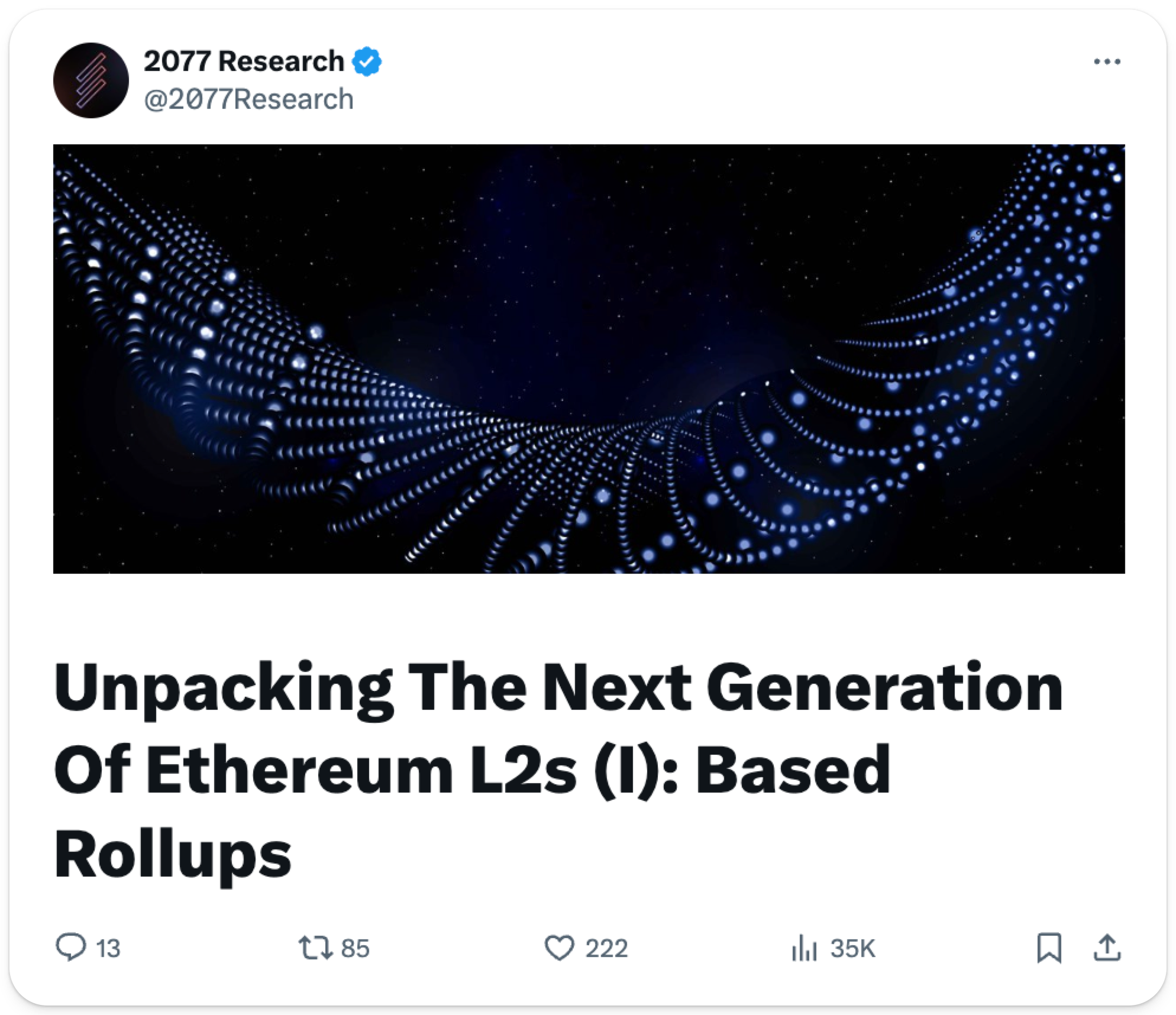Despite fierce debate, Ethereum's scalability roadmap still hinges on rollups. While rollups have undoubtedly paved the way for Ethereum’s scaling success, their lack of synchronicity with the main chain creates issues.
Rollups must maintain specialized proof mechanisms, adding significant complexity and overhead for each rollup team. They rely heavily on security councils or governance votes to stay current with Ethereum’s upgrades, causing lags and disconnect. Further, each rollup’s varied security assumptions and degrees of centralization fragment the ecosystem and slow interoperability. Meanwhile, each new Ethereum hard fork demands rollup teams to manually update to stay compatible, intensifying governance burdens and introducing fresh risks.
Against this backdrop and the battle over Ethereum’s scaling vision, many are wondering if there’s a simpler path forward — one where these L2s can remain fully synced with Ethereum without needing so much hands-on maintenance.
Cue Native Rollups—a fresh framework for how rollups can stay aligned with Ethereum by design, harnessing the entirety of the base chain’s security, rather than relying on external oversight or custom logic.
Let's dive deeper into this term and the related concepts 👇
Oh, and yeah, we recorded a podcast on this, too!
Native Rollups Decoded
Discussed and proposed by a series of ETH natives like Justin Drake and Dan Robinson, native rollups would integrate directly with Ethereum’s core transaction rules, allowing Ethereum itself to validate transactions instead of relying on external proof systems.
Today, most L2s execute transactions offchain and use proofing mechanisms to verify withdrawals and state changes. Native rollups would take a different approach by using the EXECUTE precompile — a built-in Ethereum function letting rollups process transactions using Ethereum’s own verification rules rather than relying on independent proofing.
With this setup, native rollups would post transaction data directly to Ethereum’s main chain, where Ethereum enforces its correctness. They would automatically adopt network upgrades without requiring governance votes or security councils, eliminating many of the complexities and interoperability conflicts that currently exist.
By removing the need to duplicate Ethereum’s logic, native rollups reduce maintenance overhead, simplify security, and make it easier for L2s to stay aligned with Ethereum’s evolving framework while leveraging the base chain’s entire security potential.
How Do They Compare to Other Rollups?
To better understand the significance of native rollups, let’s compare them with other new rollup approaches currently being explored.
▪️ Based Rollups
First introduced in 2021 by Vitalik Buterin, then formally defined by Justin Drake in 2023, Based rollups depend entirely on Ethereum’s Layer 1 validators for transaction sequencing, helping decentralize transaction ordering.
Taiko is live as the first based rollup, with other teams progressing the development of based rollups such as Spire Labs. But, while Ethereum’s involvement enhances decentralization, based rollups must still manage their own proof systems, resulting in potential user experience challenges due to Ethereum’s slower block times — though pre-confirmation methods are improving this.

▪️ Booster Rollups
Next, we have Booster rollups, which enhance scalability by closely replicating Ethereum’s Layer 1 execution and storage processes at Layer 2, allowing applications to expand without significant redeployment.
While this method makes it easier for existing applications to scale, it also adds complexity compared to traditional rollups, requiring more sophisticated engineering and unique proof mechanisms. Although booster rollups aim for stronger composability and simpler app deployment, they face ongoing challenges around economic incentives and providing a smooth user experience.

▪️ Native Rollups
As stated, unlike the models above, native rollups do not require separate proof frameworks or external validators. All of this is done by Ethereum itself, reducing complexity for L2s, and significantly simplifying their interplay with the base layer. As a result, they gain several key benefits:
- Massive Security Boost: Users can hold assets on a native rollup and trust them like they trust Ethereum L1. The fear that a separate rollup’s multi-sig or security council could get hacked becomes greatly reduced.
- Simpler Development: Removes the need for custom fraud or zero-knowledge proofs, easing deployment and maintenance.
- Better Ethereum Alignment: Automatically inherits Ethereum upgrades, ensuring consistency and promoting interoperability, while also receiving the quantum security that ETH will eventually adopt.
- More Efficient ZK Proofs: Bundles multiple proofs efficiently, cutting verification costs for zero-knowledge rollups.
- Promise for New App Chains: As more dApps want the highest security, they can choose to be “native” so they don’t have to reinvent the EVM, instead simply adding their own features on.
Finally, if a rollup is both native and based — meaning Ethereum manages both sequencing and transaction verification — it creates an “ultrasound rollup” that leverages Ethereum’s complete security model and remains perfectly aligned with its roadmap. The ideal rollup.
What Native Rollups Do Not Solve
While native rollups solve governance and security hurdles, they do not address all of Ethereum’s scaling constraints and further impose some limits on its diversity.
L1 gas limits remain in force, and re-executing every transaction onchain can be inefficient unless paired with additional ZK or optimistic techniques. Furthermore, native rollups must stick to the EVM model, leaving little room for the growing trend of alternative virtual machines like the SVM or MoveVM operating outside Ethereum’s execution environment.
Also, the EXECUTE precompile, which Native rollups rely on, significantly increases data availability costs, potentially raising L2 overhead by 5–10x. Beyond this, since many existing rollups are EVM-compatible but not fully EVM-equivalent, adopting the native rollup model would be difficult without significant re-engineering. Further, specialized transaction formats or custom gas accounting methods, such as wallets or applications compensating users for gas fees, would also face compatibility hurdles under native rollups, highlighting important UX trade-offs despite their benefits.
A Step Forward
While native rollups represent an important advancement for Ethereum’s scaling roadmap, not every rollup will likely adopt this approach. Instead, as some like Dogan of Cyber Fund believe, the landscape may evolve into three main types:
- Enterprise Rollups: Custom-built and controlled by businesses for prioritizing their own specific requirements, like transaction ordering or privacy.
- Performance-Focused Rollups: Maximizing transaction speed and lower costs by relying on alternative data availability solutions, like EigenDA.
- Native Rollups: Fully Ethereum-integrated, inheriting the base layer’s security and upgrading automatically, eliminating the need for external governance or separate proof mechanisms.
This would leave room for experimentation and support for alternate VMs, though also providing a method for rollups to capitalize on all the security and trust Ethereum holds. Drake believes an initial version of native rollups could appear next year. To achieve full technical maturity, including integrated zero-knowledge proofs and increased L1 gas limits, Ethereum would require even more community coordination and thorough validation, potentially pushing full implementation further into the future.
In short, while native rollups likely won’t become the only solution for scaling Ethereum, they present a simplified, secure, and closely integrated scaling option. They offer a clearer path forward — one where Layer 2s can remain tightly synced with Ethereum’s main chain without complex governance structures, creating a smoother and safer experience for users, developers, and the broader ecosystem overall.

